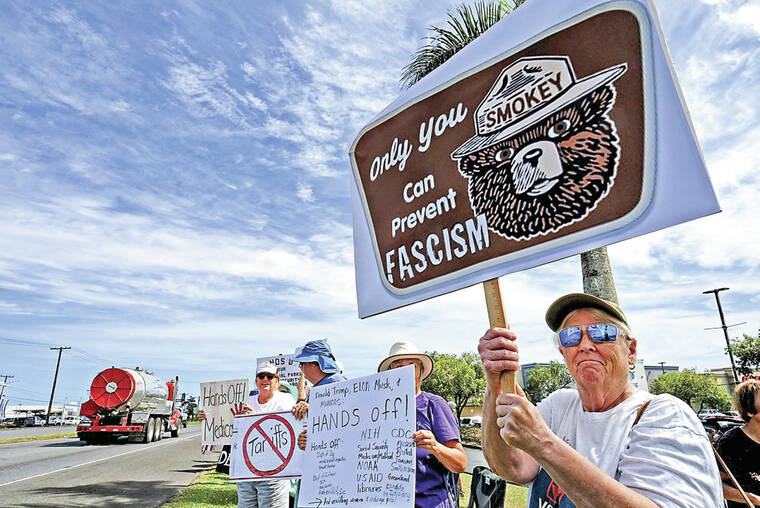A student researcher at the University of Hawaii at Hilo found that an herbicide previously used at Richardson Beach Park is potentially hazardous to nearby seaweed, or limu.
Ron Kittle, senior at UH-Hilo, said the herbicide AquaPro was used a few years ago for grass maintenance.
“In 2012, the County of Hawaii proposed to spray AquaPro herbicide to get rid of grass and weeds near the ponds,” he explained at the seventh annual Ocean Day Malama Kanaloa Festival on Sunday.
Kittle was one of a dozen educators at the event supplying the public with information on ecological and biological research and management efforts on the Big Island.
Like most presenters, he used an interactive display to attract keiki and their parents.
At Kittle’s exhibit were six cylinders filled with various types of limu including, Padina Australis, Limu aki‘aki (used in poke), Limu palahalaha (also known as sea lettuce), Limu ele‘ele, Portieria hornemannii (found on rocks at Richardson Beach Park), and Gayralia-oxysperma (found in the ponds at Richardson Beach Park).
He also had test-tubes showing healthy limu versus unhealthy limu.
While curious keiki were busy dipping their fingers in the displays, Kittle explained that his research started as an effort to see what happens to the seaweed in the ponds and off shore after the herbicide is used.
“Even with the lowest concentration used in the study, we observed plants dieing,” he said.
Turtles, and sometimes humans, consume the algae, and although the county has since ceased using the product, Kittle said people should be made aware of such herbicides and their potential effects.
“I think it’s something the community should know,” he said.
Once his research is complete, Kittle said he intends to present his findings to Hawaii County officials and nearby schools.
Along with presentations such as Kittles’ were give-away contests, live music and food.
Amelie Sterling, an Ocean Day volunteer and part of the Pacific Internship Programs for Exploring Science, said she looks forward to the family event every year.
“The event is put on by UH-Hilo and the County of Hawaii and brings together schools, community and university groups to raise awareness of the Ma kai,” she said.
Sterling said Sunday was the second year of the festival being located at Hilo Bayfront, and that the number of volunteers and attendees have grown every year.
This year’s Ocean Day presenters were Americorps; Hilo Improvement Program; C-More Scholars; Girl Scouts; Hawaii Electric Light Company; Hawaii Fish Trust; Hawaii Wildlife Fund; Hawaii Children’s Center; Hilo Intermediate School Builders Club; Hilo Marine Mammal Response Network; Hilo Student Art Association; Kokua Huakai; Kozmo Mimzi Animation Theatre; LomiLomi; Malama Ka Aina Hana Ka Aina; Marine Mammal Club; Marine Option Program; Mauna Kea Watershed Alliance; Micronesians United Big Island; Na Pua No’Eau-UHH; National Community Pharmacist Association; OD Info Booth; Pacific Biodiesel; Palekana Kai; School of Education/Prism; Surfrider Foundation Hilo; UH-Hilo Core Genetics Facility; UH-Hilo Marine Science; U.S. Forest Service.
Ocean Day is a marine and coastal resources awareness celebration hosted by the UH-Hilo’s Office of Research. The event is free and open to the public and provides hands-on activities for keiki and their families to learn about and celebrate the importance of protecting Big Island coastal and ocean ecosystems. The annual event features information on marine and coastal research, information on how to get involved with aina and kai stewardship and initiatives, and engaging presentations for community members to reconnect to the island’s resources.
Email Megan Moseley at mmoseley@hawaiitribune-herald.com
Malama means “to take care of” and Kanaloa means” a certain Deity.” In Hawaiian tradition, Kanaloa is the God of the deep sea.





